
Robert (Xing) ZhangSelective Removal Processing Division at Applied Materials Santa Clara, Ca PhD Chemistry, UNC Chapel Hill, 2017 University of Texas at Arlington 2010, M.S. Physics Tsinghua University 2006, B.S. Materials Science |

|
First Author
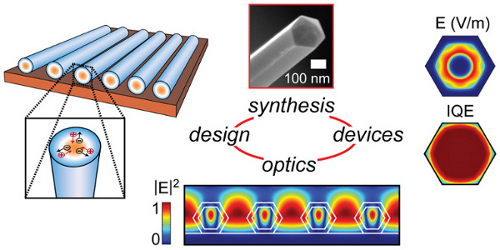

The silicon p–n junction is the most successful solar energy technology to date, yet it accounts for a marginal percentage of worldwide energy production. To change the status quo, a disruptive technological breakthrough is needed. In this Perspective, we discuss the potential for complex silicon nanowires to serve as a platform for next-generation photovoltaic devices. We review the synthesis, electrical characteristics, and optical properties of core/shell silicon nanowires that are subwavelength in diameter and contain radial p–n junctions. We highlight the unique features of these nanowires, such as optical antenna effects that concentrate light and intense built-in electric fields that enable ultrafast charge-carrier separation. We advocate a paradigm in which nanowires are arranged in periodic horizontal arrays to form ultrathin devices. Unlike conventional planar silicon, nanowire structures provide the flexibility to incorporate multiple semiconductor, dielectric, and metallic materials in a single system, providing the foundation for a disruptive, unconventional solar energy technology.
Contributing Author

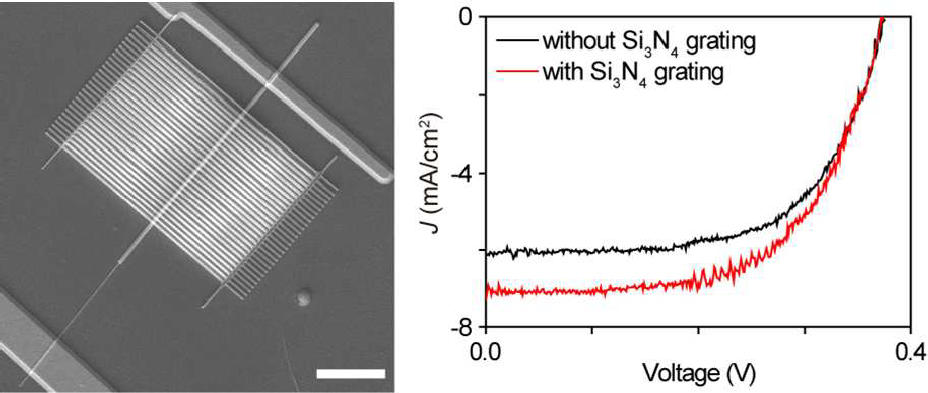
Nano Letters
We report the enhancement of light absorption in Si nanowire photovoltaic devices with one-dimensional dielectric or metallic gratings that are fabricated by a damage-free, precisely aligning, polymer-assisted transfer method. Incorporation of a Si3N4 grating with a Si nanowire effectively enhances the photocurrents for transverse-electric polarized light. The wavelength at which a maximum photocurrent is generated is readily tuned by adjusting the grating pitch. Moreover, the electrical properties of the nanowire devices are preserved before and after transferring the Si3N4 gratings onto Si nanowires, ensuring that the quality of pristine nanowires is not degraded during the transfer. Furthermore, we demonstrate Si nanowire photovoltaic devices with Ag gratings using the same transfer method. Measurements on the fabricated devices reveal approximately 27.1% enhancement in light absorption compared to that of the same devices without the Ag gratings without any degradation of electrical properties. We believe that our polymer-assisted transfer method is not limited to the fabrication of grating-incorporated nanowire photovoltaic devices but can also be generically applied for the implementation of complex nanoscale structures toward the development of multifunctional optoelectronic devices.
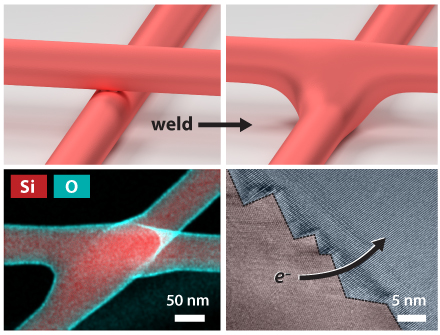
Nano Letters
Semiconductor nanowires (NWs) have been demonstrated as a potential platform for a wide-range of technologies, yet a method to interconnect functionally encoded NWs has remained a challenge. Here, we report a simple capillarity-driven and self-limited welding process that forms mechanically robust and Ohmic inter-NW connections. The process occurs at the point-of-contact between two NWs at temperatures 400–600 °C below the bulk melting point of the semiconductor. It can be explained by capillarity-driven surface diffusion, inducing a localized geometrical rearrangement that reduces spatial curvature. The resulting weld comprises two fused NWs separated by a single, Ohmic grain boundary. We expect the welding mechanism to be generic for all types of NWs and to enable the development of complex interconnected networks for neuromorphic computation, battery and solar cell electrodes, and bioelectronic scaffolds.
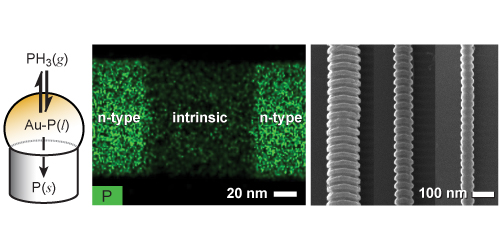
Semiconductor nanowires (NWs) are often synthesized by the vapor-liquid-solid (VLS) mechanism, a process in which a liquid droplet—supplied with precursors in the vapor phase—catalyzes the growth of a solid, crystalline NW. By changing the supply of precursors, the NW composition can be altered as it grows to create axial heterostructures, which are applicable to a range of technologies. The abruptness of the heterojunction is mediated by the liquid catalyst, which can act as a reservoir of material and impose a lower limit on the junction width. Here, we demonstrate that this “reservoir effect” is not a fundamental limitation and can be suppressed by selection of specific VLS reaction conditions. For Au-catalyzed Si NWs doped with P, we evaluate dopant profiles under a variety of synthetic conditions using a combination of elemental imaging with energy-dispersive x-ray spectroscopy and dopant-dependent wet-chemical etching. We observe a diameter-dependent reservoir effect under most conditions. However, at sufficiently slow NW growth rates (≤ 250 nm/min) and low reactor pressures (≤ 40 Torr), the dopant profiles are diameter independent and radially uniform with abrupt, sub-10 nm axial transitions. A kinetic model of NW doping, including the microscopic processes of (1) P incorporation into the liquid catalyst, (2) P evaporation from the catalyst, and (3) P crystallization in the Si NW, quantitatively explains the results and shows that suppression of the reservoir effect can be achieved when P evaporation is much faster than P crystallization. We expect similar reaction conditions can be developed for other NW systems and will facilitate the development of NW-based technologies that require uniform and abrupt heterostructures.
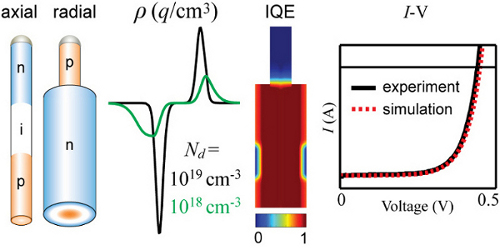
Semiconductor nanowires (NWs) are a developing platform for electronic and photonic technologies, and many demonstrated devices utilize a p-type/n-type (p–n) junction encoded along either the axial or radial directions of the wires. These miniaturized junctions enable a diverse range of functions, from sensors to solar cells, yet the physics of the devices has not been thoroughly evaluated. Here, we present finite-element modeling of axial and radial Si NW p–n junctions with total diameters of 240 nm and donor/acceptor doping levels ranging from 1016 to 1020 cm–3. We evaluate the photovoltaic performance of horizontally oriented NWs under 1 sun illumination and compare simulated current–voltage data to experimental measurements, permitting detailed analysis of NW performance, limitations, and prospect as a technology for solar energy conversion. Although high surface-to-volume ratios are cited as detrimental to NW performance, radial p–n junctions are surprisingly insensitive to surface recombination, with devices supporting open-circuit voltages (VOC) of 0.54 V and internal quantum efficiencies of 95% even with high surface recombination velocities (SRVs) of 105 cm/s. Axial devices, in which the depletion region is exposed to the surface, are far more sensitive to SRV, requiring substantially lower values of 103–104 cm/s to produce the same level of performance. For low values of the SRV (<100 cm/s), both axial and radial NWs can support VOC values of >0.70 V if the bulk minority carrier lifetime is 1 μs or greater. Experimental measurements on NWs grown by a vapor–liquid–solid mechanism yield VOC of 0.23 and 0.44 V for axial and radial NWs, respectively, and show that axial devices are limited by a SRV of 7 × 103 cm/s while radial devices are limited by a bulk lifetime of 3 ns. The simulations show that with further development the electrical characteristics of 200–300 nm Si NWs are sufficient to support power-conversion efficiencies of 15–25%. The analysis presented here can be generalized to other semiconductor homo- and heterojunctions, and we expect that insights from finite element modeling will serve as a powerful method to guide the design of advanced nanoscale structures.